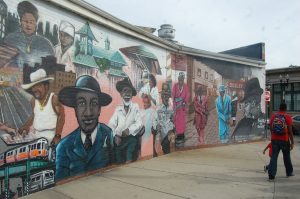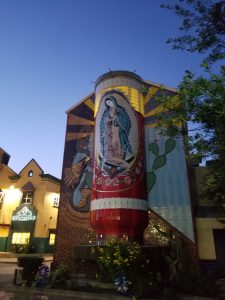Change, it is the one constant in the story of human history. Nothing stays the same, attempting to fight change is an exercise in futility. To survive the change of time all things must adapt and adjust to a new paradigm. Failure to change means death, whether we are discussing dinosaurs or giant corporations. Sometimes change can be beneficial, things shift in a positive direction and people’s lives improve. Other times changes are not so good, life becomes more difficult or important knowledge is lost. One of the byproducts of change is gentrification. Some argue that gentrification is good because it revitalizes blighted neighborhoods; contrarily it’s a force of destruction of personal history and economically disadvantaged people. How can a historic neighborhood hold on to its history and benefit the people who currently live there?
San Antonio: The Historic West Side
Walking along the streets of the historic west side of San Antonio the surrounding history is palatable, however so is the destruction of that history. Land speculators are leaving lots empty in hopes of a big payday sometime in the future while razing older properties and replacing them with buildings that are more modern. This leads to the destruction of the community’s history and forces the people who live there to move due to rising rents and other economic hardships. The Esperanza Center has been pushing back against these speculators in an attempt to hold on to the history and culture of the neighborhood for the people that live there. Their approach is to acquire properties and restore them for new tenants or re-purpose them so that they will avoid being torn down. This is a good approach but the speculators impede the process by leaving lots empty lots or even worse, hampering the attempts to improve the neighborhood by placing fences on their properties in inconvenient places. Their approach is direct but requires large financial backing and cooperation from local politicians. This brings up another roadblock for the Center’s mission; the politicians are not invested in saving old buildings. The people in charge are going to take their directions from their political donors, and those donors want to make money developing the neighborhood. Current political climates favors the people who drive gentrification. There are opportunities to make money that do not include saving the history of old neighborhoods; revitalization in the name of progress is the fuel of gentrification. It is a tough uphill battle; however, the people of the Roxbury section of Boston tried a more radical approach.

Boston: Roxbury
Gentrification happens when the local people do not have direct control over their neighborhood. The blog Black Perspectives talks about the events in the Roxbury district of Boston, MA. During the 1980’s in Boston, a couple of men tried to stand up and improve their neighborhood by taking the neighborhood away from the city. Curtis Davis and Andrew Jones formed a group called The Greater Roxbury Incorporation Project (GRIP) with the goal being leaving Boston proper and forming a new incorporated city that the local people would control. Even though Boston was the idealistic center of the American Revolution, its city planners were not so forward thinking over the years. Boston became the most segregated city in the Northern US, making it very susceptible to the forces of gentrification. In forming a new city out of the old neighborhoods, the people could stop this process and revitalize the area for its residents. By spending resources on attracting economic opportunities that would not drive out the economically disadvantaged residents, the city would stop the process of gentrification. Ultimately, GRIP did not achieve its master goal of independence, however it did succeed it getting reforms into government that would eventually aid the area and make improvements to benefit the people there.
Two Paths, One Goal
The Esperanza Center and GRIP are just two examples of people trying to control the destinies of their local neighborhoods and deter the process of gentrification. I hope that they will succeed in protecting the history that the people in city hall easily neglect. It is easy to order a building toppled when it is just numbers on a budget sheet, but to the people who live there those building mean so much more. They are touchstones to loved ones who are no longer with them. Preserving the buildings is to preserve the memories of those who came before us and made us into what we are today.


It’s kind of scary how so many people argue FOR gentrification when the damage it does to the community is so apparent. It’s akin to the slash and burn method of agriculture, but involving neighborhoods and livelihoods. Learning about Boston and the fate of the GRIP project makes the situation right here at home in San Antonio seem even more important and endangered.
Hey there Scott! I’m glad you brought up such touch subjects when looking at our trip to the Esperanza Peace and Justice Center’s site because I know that personally I tend to look at all the positive and lean away from the negative aspects of what I learned but because of those types of personal pushbacks, the story may not be shared. Thank you for reminding me and our readers what the “other side of the story” really is.
……Ugh!! This touches so many parts of my childhood. As I had mentioned, As a kid I grew up in some of these areas. My earliest memories are filled with pictures of what this area or that looked like. Thinking back on some of this, this might have been where I began to gain a love for history. For those who lived in some of these places it really is so much more than brick and mortar. For a lot of these families its where grandma or grandpa pass away because hospital stays are to expensive, its where birthday parties turn into community bar b ques because yards are not sectioned off. Its where even today kids still play out side, what a concept right?
The idea of Gentrification is an idea that is overlooked in many political arenas. I feel like many people do not quite understand what this word means. This may be the case for residents of the west side also. I am thinking a more positive outreach would be to go and explain to the people of the San Antonio West what you think is happening and just listen to their stories. Some may realize that they finally have a word to what they are seeing around them and can now see examples of what happens from other communities. Just talking about these concerns is a great step in the right direction.